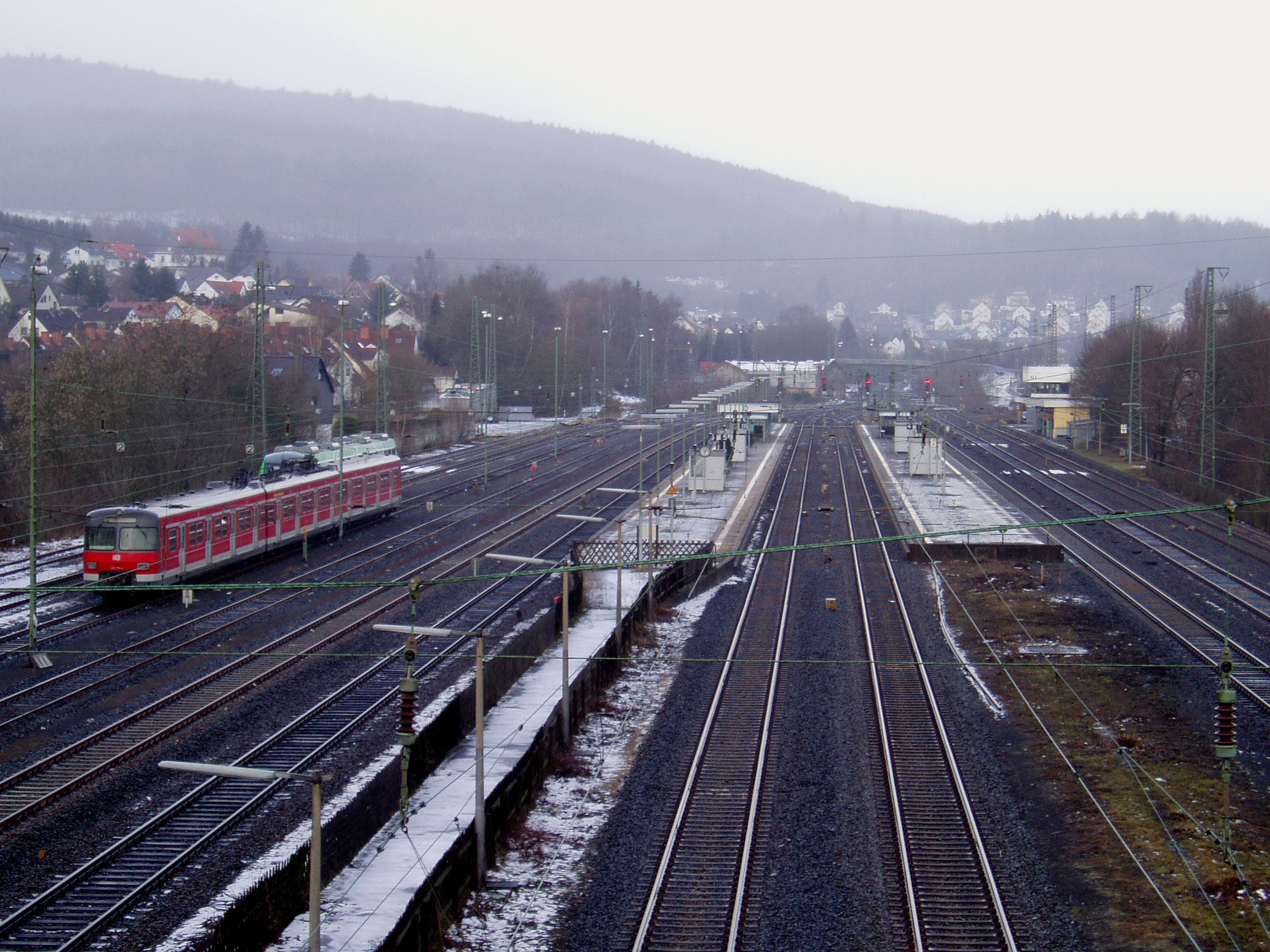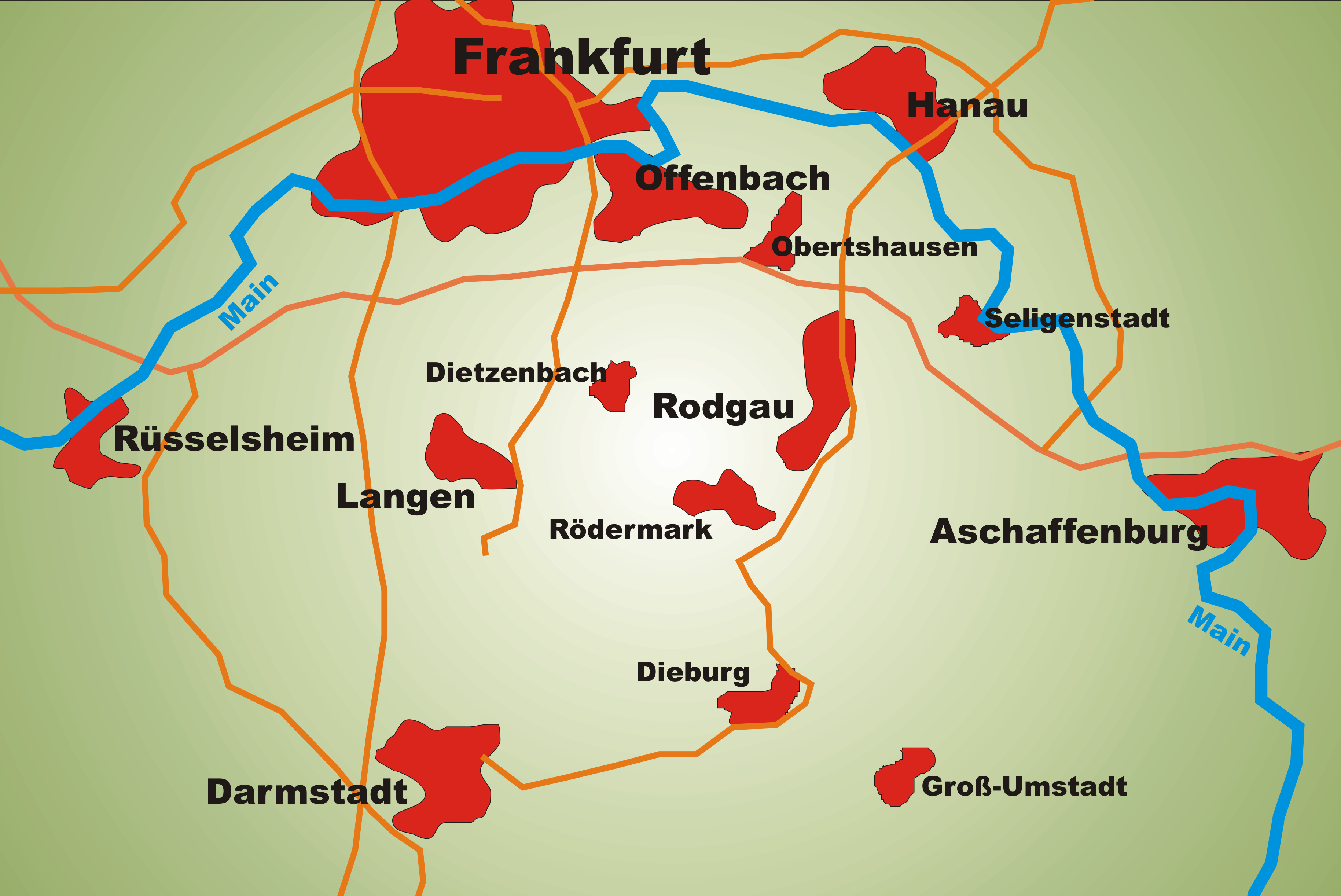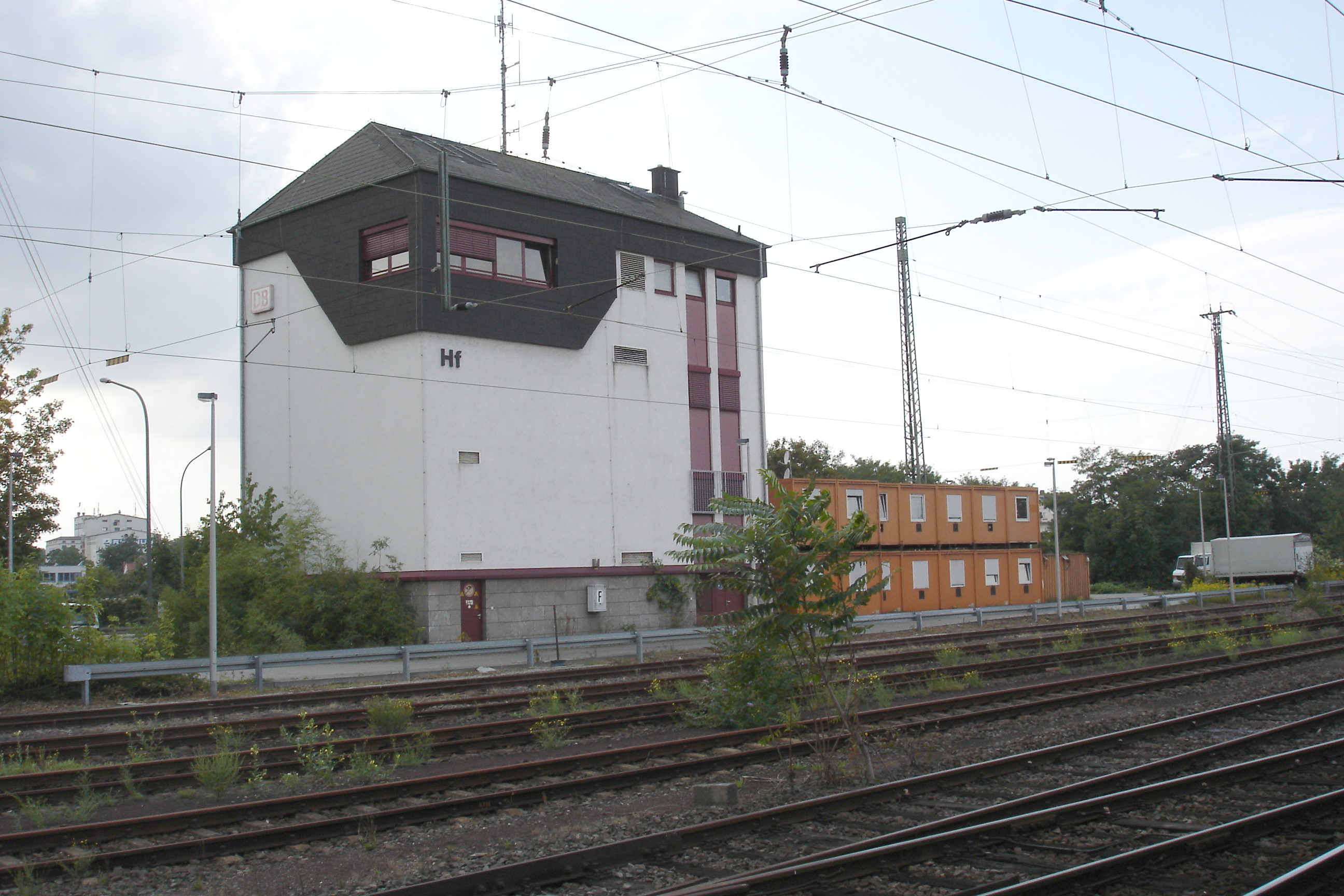|
Babenhausen Station
Babenhausen (officially: ''Babenhausen (Hess)'') station is a junction station at the intersection of the Rhine-Main Railway (german: Rhine-Main-Bahn) and the Odenwald Railway (german: Odenwaldbahn) in the town of Babenhausen in the German state of Hesse. History The station was built for the Rhine-Main Railway and put into operation on 25 December 1858. In 1868, the first section of the Odenwald Railway was opened to Groß-Umstadt. In 1876, the three-storey station building was erected, which still stands today. It was built in light-coloured sandstone. In 1904, a small restaurant was opened. The station building is listed as a monument under the Hessian Heritage Act. In the 1920s, work began on rebuilding the station to deal with increasing traffic. The tracks were raised 5 metres and the level crossings over Aschaffenburger and Darmstadter Straße were closed. An underpass was built immediately next to the station building for today’s federal highway B 26. This work was c ... [...More Info...] [...Related Items...] OR: [Wikipedia] [Google] [Baidu] |
Babenhausen, Hesse
Babenhausen () is a town in the Darmstadt-Dieburg district, in Hesse, Germany. Geography It is situated on the river Gersprenz, 25 km southeast of Frankfurt, and 14 km west of Aschaffenburg. South of its general borders, the mountain range of the Odenwald is situated about 15 km away. The landscape is rather flat due to the landscape forming process of the Gersprenz and other small rivers. Some sections along the Gersprenz are set aside as nature reserves with valuable plants and animals, e.g. the white stork or the kingfisher. The forests in the municipal area are mostly pine woods on ice-age dunes with heath fields. The sandy soil is regionally famous for growing white asparagus. History The town of Babenhausen includes a medieval core with a castle (12-13th century), numerous old houses and a large part of the city wall (1445). Babenhausen was chartered as a town in 1295. It belonged first to the Lords of Hanau-Münzenberg and was – after the last male desce ... [...More Info...] [...Related Items...] OR: [Wikipedia] [Google] [Baidu] |
Groß Gerau Station
Groß Gerau station is located approximately 500 metres north of the centre of the town of Groß-Gerau in the German state of Hesse on the Rhine-Main Railway, running from Wiesbaden and Mainz to Darmstadt and Aschaffenburg. A curve branches off near the station connecting to the nearby Groß-Gerau-Dornberg station on the Mannheim–Frankfurt railway. The station is classified by Deutsche Bahn as a category 5 station. The station name has no hyphen unlike the town it is in, following a Prussian government order of 1910, which applied because of Prussian finance for the line, even though the station was in the Grand Duchy of Hesse. History The station was opened with the section of the Rhine-Main Railway between Mainspitze and Darmstadt opened by the Hessian Ludwig Railway (''Hessische Ludwigsbahn'') in 1858. In Groß-Gerau, a wooden hut served as the station building. A new station building was opened in 1868. During the First World War, a volunteer ambulance corps and a branch ... [...More Info...] [...Related Items...] OR: [Wikipedia] [Google] [Baidu] |
Railway Stations In Hesse
Rail transport (also known as train transport) is a means of transport that transfers passengers and goods on wheeled vehicles running on rails, which are incorporated in tracks. In contrast to road transport, where the vehicles run on a prepared flat surface, rail vehicles (rolling stock) are directionally guided by the tracks on which they run. Tracks usually consist of steel rails, installed on sleepers (ties) set in ballast, on which the rolling stock, usually fitted with metal wheels, moves. Other variations are also possible, such as "slab track", in which the rails are fastened to a concrete foundation resting on a prepared subsurface. Rolling stock in a rail transport system generally encounters lower frictional resistance than rubber-tyred road vehicles, so passenger and freight cars (carriages and wagons) can be coupled into longer trains. The operation is carried out by a railway company, providing transport between train stations or freight customer facilit ... [...More Info...] [...Related Items...] OR: [Wikipedia] [Google] [Baidu] |
S2 (Rhine-Main S-Bahn)
The S2 service of the S-Bahn Rhein-Main system bearing the KBS (German scheduled railway route) number 645.2 is a railway connection between the small Taunus town Niedernhausen and Dietzenbach. Usually DBAG Class 423 railcars are used on this service. Its predecessor class 420 is only used for shortened shuttle services. According to a news report issued by ''Hessenschau'', the S2 is the least punctual of the system, with only 83% of trains leaving on time. Routes Main-Lahn railway The service uses the tracks of the Main-Lahn Railway between Niedernhausen and Frankfurt Central Station. This route is also used by regional trains in the section Niedernhausen–Frankfurt-Höchst. Between Frankfurt-Höchst and Central Station this service shares the Main-Lahn line with freight and shunting operations. National and regional services use the parallel running Taunus railway in this section. The Main-Lahn railway was completed on 15 October 1877 and has been used by S-Bahn servi ... [...More Info...] [...Related Items...] OR: [Wikipedia] [Google] [Baidu] |
Rhine-Main S-Bahn
The Rhine-Main S-Bahn system is an integrated rapid transit and commuter train system for the Frankfurt/Rhine-Main region, which includes the cities Frankfurt am Main, Wiesbaden, Mainz, Offenbach am Main, Hanau and Darmstadt. The network comprises nine S-Bahn lines, eight of which currently travel through the cornerstone of the system, a tunnel (the "City Tunnel") through central Frankfurt. The first section of this tunnel was opened on May 28, 1978. Further tunnel sections were opened in 1983 and 1990, before its completion in 1992. The system belongs to the Rhein-Main-Verkehrsverbund (RMV) and is operated by DB Regio, a subsidiary of Deutsche Bahn. End-to-end journey times on the nine lines in the system range from 36 minutes (on line S7) up to 87 minutes (on line S1). The longest journey time into central Frankfurt ( Hauptwache), from any point on the network, is 54 minutes. Services on some lines start shortly after 4a.m., while all lines have services from about 5a.m. on ... [...More Info...] [...Related Items...] OR: [Wikipedia] [Google] [Baidu] |
Rodgau
Rodgau is a town in the Offenbach district in the ''Regierungsbezirk'' of Darmstadt in Hesse, Germany. It lies southeast of Frankfurt am Main in the Frankfurt Rhine Main Region and has the greatest population of any municipality in the Offenbach district. It came into being in 1979 when the greater community of Rodgau was raised to town, after having been formed through a merger of five formerly self-administering communities in the framework of municipal reform in Hesse in 1977. The current constituent communities’ history reaches back to the 8th century. Geography Location Rodgau is part of the metropolitan area known as the Rhein-Main-Gebiet in German, one of Germany's economically strongest areas. The fiftieth parallel of north latitude (50°N) passes right through Puiseaux-Platz (square) in Nieder-Roden. The town lies on the so-called ''Untermainebene'', or Lower Main Plain, the northern outlying part of the Rhine rift. The flat land around Rodgau is set against hi ... [...More Info...] [...Related Items...] OR: [Wikipedia] [Google] [Baidu] |
Großostheim
Großostheim (or ''Grossostheim'') is a market community in the Aschaffenburg district in the ''Regierungsbezirk'' of Lower Franconia (''Unterfranken'') in Bavaria, Germany. The inhabitants call themselves ''Aistmer'' (''ostheimers''). Geography Location Großostheim lies on the northeast edge of the Odenwald in the Bavarian Lower Main (''Bayerischer Untermain'') region. Constituent communities Großostheim's ''Ortsteile'' are Großostheim, Pflaumheim, Wenigumstadt and Ringheim. Neighbouring communities Clockwise from the north, these are the community of Stockstadt, the district-free town of Aschaffenburg, the community of Niedernberg, the community of Mömlingen (both in Miltenberg district) and the community of Schaafheim (Darmstadt-Dieburg). Together with Stockstadt am Main and the neighbouring Hessian community of Schaafheim, the market community forms the historic Bachgau region. History The market community of Großostheim, as a greater community, is made up of the ... [...More Info...] [...Related Items...] OR: [Wikipedia] [Google] [Baidu] |
Schaafheim
Schaafheim is a municipality in the Darmstadt-Dieburg district, in Hesse, Germany Germany,, officially the Federal Republic of Germany, is a country in Central Europe. It is the second most populous country in Europe after Russia, and the most populous member state of the European Union. Germany is situated betwe .... References Darmstadt-Dieburg {{Hesse-geo-stub ... [...More Info...] [...Related Items...] OR: [Wikipedia] [Google] [Baidu] |
Erbach Im Odenwald
Erbach () is a town and the district seat of the Odenwaldkreis (district) in Hesse, Germany. It has a population of around 13,000. Geography Location The town lies in the ''Mittelgebirge'' Odenwald at elevations between 200 and 560 m in the valley of the Mümling. One geological peculiarity is the creek Erdbach's complete disappearance within Dorf-Erbach's community area. The Erdbach reappears near Stockheim. There are several places where the Erdbach disappears into the ground. Neighbouring communities Erbach borders in the north on the town of Michelstadt, in the east on the market town of Kirchzell (in Miltenberg district in Bavaria), in the south on the community of Hesseneck and the town of Beerfelden and in the west on the community of Mossautal (all three in the ''Odenwaldkreis''). A planned merger with the neighbouring town of Michelstadt was blocked in November 2007 by a referendum (''Bürgerentscheid''). For the time being, ways are being sought to deepen th ... [...More Info...] [...Related Items...] OR: [Wikipedia] [Google] [Baidu] |
Hanau Hauptbahnhof
Hanau Hauptbahnhof is a railway station in Hanau in the German state of Hesse, and is a major railway junction east of Frankfurt am Main. It was opened in 1867, but the current building was built in the late 1960s. It is located about south-east of central Hanau. It is classified by Deutsche Bahn (DB) as a German railway station categories, category 2 station and has many train services, including Intercity Express, regional and Rhine-Main S-Bahn, S-Bahn services. Links Hanau Hauptbahnhof is a central hub of the railway network that is served by six routes. It is served by: * Frankfurt-Hanau Railway, Frankfurt-Hanau Railway (Hanau–Maintal–Frankfurt) * Main-Spessart Railway, Main-Spessart Railway (Hanau–Kahl–Aschaffenburg) * Frankfurt-Bebra Railway ** towards the east: Kinzig Valley Railway (Hesse), Kinzig Valley Railway, Hanau–Fulda–Göttingen ** towards the west: Offenbach am Main–Frankfurt am Main, as the South Main S-Bahn * Friedberg–Hanau railway to Friedberg ... [...More Info...] [...Related Items...] OR: [Wikipedia] [Google] [Baidu] |
Frankfurt (Main) Hauptbahnhof
Frankfurt (Main) Hauptbahnhof, also called Frankfurt Central Station and Frankfurt Main Station, is the busiest railway station in the German state of Hesse. Because of its location near the middle of Germany and usage as a transport hub for long and short distance travelling, Deutsche Bahn refers to it as the most important station in Germany. Name The affix "Main" comes from the city's full name, ''Frankfurt am Main'' ("Frankfurt on the River Main") and is needed to distinguish it from Frankfurt (Oder) station on the River Oder in Brandenburg. In German, the name is often abbreviated as Frankfurt (Main) Hbf. History 19th century In the late 19th century, three stations connected Frankfurt to the west, north and south, the *''Taunus station'' for the Taunusbahn (opened 1839), connecting Frankfurt to Wiesbaden *''Main-Neckar-station'' for the Main-Neckar Railway to Darmstadt, Heidelberg and Mannheim (1848)) *''Main-Weser station'' for the Main–Weser Railway to Kasse ... [...More Info...] [...Related Items...] OR: [Wikipedia] [Google] [Baidu] |
Aschaffenburg Hauptbahnhof
Aschaffenburg Hauptbahnhof is the main station of Aschaffenburg in the German state of Bavaria. It is located on the busy Ruhr– Frankfurt–Nuremberg–Munich/Vienna rail corridor. Deutsche Bahn classifies it as a category 2 station. It forms the boundary between the city centre and the district of Damm. History The passenger station was originally located at the modern marshalling yard, which has been mostly dismantled. The station was opened in 1854 with the commissioning of the Bavarian Ludwig Western Railway (''Ludwigs-West-Bahn'']) on what was then a green field. During the Second World War, the station as a hub represented a target for Allied air raids, including on the night of 1/2 April 1942. The original station building was destroyed in an air raid on the railway facilities on 29 December 1944. In the first half of the 1950s, a new building by Hans Kern was built on the same site in an New Objectivity (architecture), objective style. The entrance hall had a large g ... [...More Info...] [...Related Items...] OR: [Wikipedia] [Google] [Baidu] |






